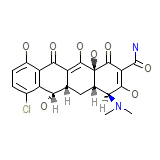Clortetrin




Categorie
Clortetrin Les marques, Clortetrin Analogs
- 6-Demethyl-7-chlorotetracycline
- 6-Demethylchlorotetracycline
- 7-Chloro-6-demethyltetracycline
- Bioterciclin
- Clortetrin
- DMCT
- DMCT (antibiotic)
- Declomycin
- Deganol
- Demeclociclina [INN-Spanish]
- Demeclocycline HCL
- Demeclocycline [USAN:BAN]
- Demeclocycline hydrochloride
- Demeclocyclinum [INN-Latin]
- Demeclor
- Demethylchlorotetracycline
- Demethylchlortetracyclin
- Demethylchlortetracycline
- Demethylchlortetracycline hydrochloride
- Demethylchlortetracyclinum
- Demetraclin
- Diuciclin
- Elkamicina
- Ledermycin
- Ledermycin hydrochloride
- Methylchlorotetracycline
- Mexocine
- Novotriclina
- Perciclina
- Sumaclina
- Tri-demethylchlortetracycline
Clortetrin Les marques melange
Clortetrin Formule chimique
C21H21ClN2O8
Clortetrin RX lien
http://www.rxlist.com/cgi/generic3/demeclocycline.htm
Clortetrin FDA fiche
Clortetrin msds (fiche de securite des materiaux)
Clortetrin Synthese de reference
Aucune information disponible
Clortetrin Poids moleculaire
464.853 g/mol
Clortetrin Point de fusion
220-223 oC
Clortetrin H2O Solubilite
1520 mg / L
Clortetrin Etat
Solid
Clortetrin LogP
-0.08
Clortetrin Formes pharmaceutiques
Tablet (150 mg/300 mg)
Clortetrin Indication
Utilisé principalement pour traiter la maladie de Lyme, l'acné, et la bronchite. Également indiqué (mais rarement utilisé) pour traiter les infections des voies urinaires, les maladies des gencives, le paludisme et autres infections bactériennes telles que la gonorrhée et chlamydia. Un de ses autres utilisations homologuées est le traitement de l'hyponatrémie (faible concentration de sodium dans le sang) due au syndrome de l'hormone antidiurétique inappropriée (SIADH) où seuls une restriction hydrique a été inefficace.
Clortetrin Pharmacologie
Déméclocycline est un antibiotique tétracycline actif contre les micro-organismes suivants: Rickettsies (pourprée des montagnes Rocheuses, la fièvre typhoïde et le groupe typhus, la fièvre Q, la variole rickettsies, cochez fièvres) , Mycoplasma pneumoniae (PPLO, Eaton agent), les agents de la psittacose et l'ornithose, des agents de lymphogranulomavenereum et le granulome inguinal, l'agent spirochetal de fièvre récurrente (Borrelia recurrentis) , Haemophilus ducreyi (chancre mou), Yersinia pestis, Pasteurella pestis et Pasteurella tularensis, Bartonella bacilliformis, Bacteroides, Vibrio comma et le fœtus Vibrio, et des espèces de Brucella (en conjointement avec la streptomycine). Demeclocycline inhibe la croissance cellulaire en inhibant la traduction. Déméclocycline est lipophile et peut facilement passer à travers la membrane cellulaire ou passivement diffuse à travers porine canaux dans la membrane bactérienne. Déméclocycline est bactériostatique (elle porte atteinte à la croissance bactérienne mais ne tuent pas les bactéries directement). Parce qu'il est excrété plus lentement que la tétracycline, il maintient les taux sanguins efficaces pendant de plus longues périodes de temps.
Clortetrin Absorption
Les tétracyclines sont facilement absorbées.
Clortetrin Toxicite
Voie orale, rat: DL50 = 2372 mg / kg
Clortetrin Information pour les patients
Demeclocycline hydrochloride is a pill given by mouth, usually 2 to 4 times a day. Take the pill on an empty stomach with a full glass of water, 1 hour before or 2 hours after eating a meal or dairy products like milk, yogurt, and ice cream. If you have nausea when taking the medicine, take it with a cracker but no dairy products. If you are also taking iron pills, take the iron pills 2 hours before or 3 hours after the demeclocycline hydrochloride pill. Keep the medicine in a tightly closed container away from heat and moisture and out of the reach of children and pets. Do not drive a car or operate heavy machinery until you know the effect that demeclocycline hydrochloride has on you. If you are dizzy, lightheaded, or feel tired, you should not drive or operate heavy machinery. Stop the drug and call your doctor or nurse right away if you develop a rash, fever, muscle aches, diarrhea with abdominal cramping, or blood or pus in your stool. This can be a serious reaction and needs to be treated right away.
Clortetrin Organismes affectes
Bactéries entériques et d'autres eubactéries














